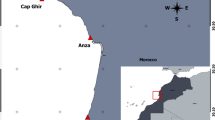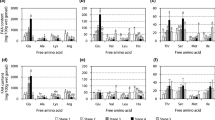Summary
The content of total and bound magnesium of the eggs ofPseudocentrotus depressus andHemicentrotus pulcherrimus was estimated by atomic absorption spectrophotometry. The amount of total magnesium was almost equal (0.128 gmg/μg PO4) in both species and did not change upon fertilization. Bound magnesium decreased in fifteen minutes after fertilization and recovered the original value in further fifteen minutes. The role of magnesium in the fertilization process was discussed with the presence of the experimental results.
Similar content being viewed by others
References
Heilbrunn, L. V., 1928: The colloid chemistry, Berlin: Borntraeger.
—,D. Mazia, andH. B. Steinbach, 1934: Free and bound calcium in stimulation and injury. Anat. Rec.60, 32.
Hori, R., 1963: Fertilization reaction and inorganic constituents of animal eggs. (In Japanese.) Jap. J. Exp. Morphol.17, 79–85.
—, 1972: On the water-soluble protein of sea urchin eggs and its changes during the early development. Protoplasma74, 459–463.
Hsiao, S. C., andH. Boroughs, 1958: The uptake of radioactive calcium by sea urchin eggs. I. Entrance of Ca45 into unfertilized egg cytoplasm. Biol. Bull.114, 196–204.
Ishikawa, M., 1962: The relation between the incorporation of phosphorus and the induction of cleavage by hypertonic treatment in the sea urchin egg. Embryologia7, 109–126.
Lindvall, S., andA. Carsjö, 1951: On protein fraction and inorganic ions in sea urchin eggs, unfertilized and fertilized. Exp. Cell Res.2, 491–498.
Lundblad, G., 1949: Proteolytic activity in eggs and sperm from sea urchins. Nature163, 643.
—, 1950: Proteolytic activity in sea urchin gametes. Exp. Cell Res.1, 264–271.
Mano, Y., andH. Nagano, 1970: Mechanism of release of maternal messenger RNA induced by fertilization in sea urchin eggs. J. Biochem.67, 611–628.
Mazia, D., 1937: The release of calcium inArbacia eggs on fertilization. J. Cell. and Comp. Physiol.10, 291–304.
Monroy, A., 1956: Some experiments concerning the chemical mechanisms of the activation of the sea urchin egg. Exp. Cell Res.10, 320–323.
—, 1965: Chemistry and physiology of fertilization. New York: Holt Reinhart and Winston.
Monroy-Oddo, A., 1946: Variations in Ca und Mg content inArbacia eggs as a results of fertilization. Experientia2, 371–372.
Nakamura, M., 1950: Phosphate determination in bilogical materials. (In Japanese.) Agric. Chem.24, 1–8.
Nakano, E., 1960: Ca metabolism of egg cell. (In Japanese.) Zool. Mag.69, 21.
—,A. Tyler, andA. Tsuzaka, 1962: Metabolic pools during the early development. (In Japanese.) Symp. Soc. Cell. Chem.12, 149–157.
Ricotta, C. M., 1956: Increase of the non-protein amino nitrogen in sea-urchin eggs upon fertilization. Naturwissenschaften43, 258–259.
Sugiyama, M., 1947: Studies on the artificial parthenogenesis in the sea urchin eggs. II. Effect of inorganic ions to membrane formation by treatment of urea. (In Japanese.) Zool. Mag.57, 183–184.
—, 1949: Studies on the artificial parthenogenesis in the sea urchin eggs. XII. Effect of Ca-defect. (In Japanese.) Zool. Mag.72, 252–255.
Vacquier, V. D., D. Epel, andL. A. Douglas, 1972: Sea urchin eggs release protease activity at fertilization. Nature237, 34–36.
Yamagami, K., 1963: Change in the amounts of some endogenous phosphate in the development of the sea urchin. (In Japanese.) Zool. Mag.72, 252–255.
Yamamoto, T., 1961: Physiology of fertilization in fish eggs. Internat. Rev. Cytol.12, 361–405.
Author information
Authors and Affiliations
Rights and permissions
About this article
Cite this article
Hori, R., Yoshida, T. On the magnesium content in sea urchin eggs and its changes accompanying fertilization. Protoplasma 77, 137–140 (1973). https://doi.org/10.1007/BF01287297
Received:
Issue Date:
DOI: https://doi.org/10.1007/BF01287297




